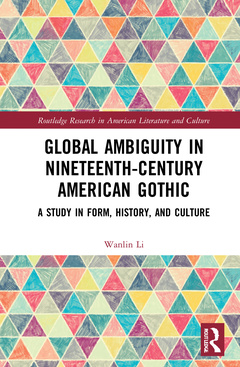Global Ambiguity in Nineteenth-Century American Gothic A Study in Form, History, and Culture Routledge Research in American Literature and Culture Series

As part of a larger attempt to understand the dynamic interactions between gothic form and ideology, this volume focuses on a strong formal feature of the American gothic, "global ambiguity," and examines the important cultural work it performs in the nineteenth-century history of the genre.
The author defines "global ambiguity" as occurring in texts whose internal evidence supports equally plausible and yet mutually exclusive interpretations. Combining insights from narrative theory and cultural studies, she investigates the narrative origin of global ambiguity and the ways in which it produces culturally meaningful readings. Canonical works and obscure ones from American gothic authors such as Charles Brockden Brown, Edgar Allan Poe, Nathaniel Hawthorne, Herman Melville, Louisa May Alcott, and Henry James are reexamined. This study reveals that the nineteenth-century American gothicists developed the gothic into an aesthetically sophisticated mode that engaged intensely with the pressing problems of American society, including moral citizenship, slavery, and the social status of women, and reimagined social realities in politically constructive manners.
Literary scholars, students, and general readers interested in gothic literature, American literature, or narrative theory will find this book informative and inspiring.
1. Introduction: A Cultural Narratological Perspective on Global Ambiguity in the American Gothic 2. The Politics of Reading: Ambiguity, Yellow Fever, and Citizenship Education in Charles B. Brown’s Arthur Mervyn 3. Edgar Allan Poe’s Gothic Aesthetics and Politics: Ambiguity and Rhetorical Sublimity in "Ligeia" and "The Fall of the House of Usher" 4. Navigating the Literary Marketplace: Allegory, Gothicism, and Ambiguity in Hawthorne’s "Young Goodman Brown" and "Rappaccini’s Daughter" 5. Return of the Repressed: Racial and Gender Politics in the Uncanny Gothic of Herman Melville and Louisa May Alcott 6. Ambiguity and Gender Politics of Authorship in Henry James’ The Turn of the Screw and "The Ghostly Rental"
Wanlin Li is an assistant professor in the Department of English at Peking University. Her teaching and research interests include gothic literature, nineteenth-century American literature, and narrative theory. Her publications have appeared or are forthcoming in Narrative,Style, Journal of Narrative Theory, and many leading journals of literary studies in China, including Foreign Literature Review, Foreign Literature, and Foreign Literatures.
Date de parution : 09-2023
15.6x23.4 cm
Date de parution : 05-2021
15.6x23.4 cm
Thème de Global Ambiguity in Nineteenth-Century American Gothic :
Mots-clés :
American Gothic Literature; Gothic Aesthetics and Politics; 19th-century American Literature; Henry James; Narrative Theory; American Gothic; Global Ambiguity; Canonical works; Contemporary Society; Charles Brockden Brown; Gothic literature; Vice Versa; American literature; Young Goodman Brown; European Gothic; Gothic Aesthetics; Piazza Tales; Cultural Justification; Edgar Huntly; Gothic Reader; British Gothic; Domestic Fiction; Rhetorical Sublime; Gothic Form; Yellow Fever; Medical Advertiser; Benito Cereno; Lover’s Return; Psychological Readings; Alcott’s Story; Gothic Materials; Melville’s Critique



